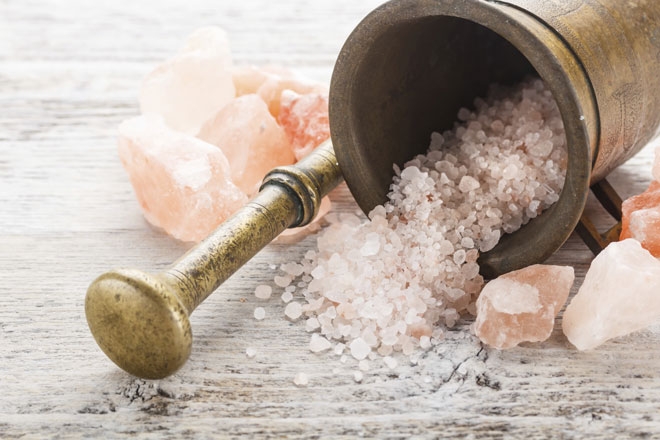 Submitted by Touch on
Submitted by Touch on

By Bess O'Connor
Oh how I jumped for joy when I heard the news that there was, in fact, a salt that was good for my health.
But wait.
Isn’t salt a huge no no? A dietary poison of sorts, contributing to cardiovascular disease, obesity and other undesirable health conditions?
Where does this salt dogma come from and is it true?
Shockingly, here’s what research has shown:
- Even small decreases in sodium intake in diet increases the risk for a cardiovascular event and even death.
- Consuming higher than average amounts of sodium does not increase risk for hypertension, stroke, or heart attack.
- A 2010 study from Harvard University showed that individuals on a salt restricted diet developed insulin resistance in only 7 days. Insulin resistance is a scary condition and a prime catalyst for developing Type 2 Diabetes.
- Individuals with Type 1 or Type 2 Diabetes die in larger numbers when on a salt restricted diet.
Sounds like good news for salt lovers worldwide! But hold your horses, not so fast. There are many different types of salt and certainly not all are created equal. Table salt, for example, is so heavily processed that all the good stuff has been removed. Not to mention the additives and preservatives to keep the salt from clumping may have potentially harmful effects on your health too.
Himalayan sea salt, on the other hand, carries 84 different trace minerals, (such as calcium, magnesium, copper, potassium and iron) that are required for the human body to function optimally. It also balances the pH in your cells and remineralizes your entire physiology.
The majestic Himalayan mountain range spans across Asia passing through China, India, Nepal, Burma (Myanmar), Pakistan, Bhutan and Afghanistan. And deep within the Himalaya’s, there's GOLD in 'dem 'der hills! But this “gold” is actually a prehistoric pink salt that’s from crystallized sea salt beds, once covered by lava. The pristine environment, freezing cold temperatures plus the lava cover are all thought to protect the salt from pollution and is heralded as the purest form of salt in all the land.
So as you can see, table salt and Himalayan sea salt, though debatebly taste the same, are two completely different compounds. One is detrimental to your health, the other is healing.
So, how can Himalayan sea salt benefit your health?
It keeps you hydrated. When people think salt, they often think dehydration, but actually the opposite is true when it comes to this salty pink goodness. It actually balances the water absorption in your body. Whenever your body takes in too little sodium, it disturbs the balance or water and electrolytes.
On the other hand, too much sodium (from table salt) can be harmful too. When there is excess sodium, the body needs to get rid of it, so it pulls water out of your cells to flush away the sodium. And the problem with that is, your body has MANY other needs for that water! That’s when we experience major dehydration which can cause dizziness, fatigue, headaches, constipation, and even kidney stones.
Increasing your water intake won’t help either. Studies have shown that for every gram of table salt your body can't process, it uses 20 times more cellular water than it would to process the sodium in Himalayan salt. So especially during the summertime, reach for the pink stuff.
It can regulate hunger. When your body is depleted of certain minerals, it’s like a fiend, constantly sending craving signals to your brain in hopes of getting a hit of electrolytes.
You think you have a salt fetish, but really you have a mineral deficiency.
When your body is thirsting for junk foods, you can almost guarantee that your body is depleted in the minerals in unrefined salt (another name for Himalayan salt). Some experts even recommend shaking a little bit of salt in your water daily! However, I believe this is highly unnecessary for most.
It’s heart healthy. Though contrary to popular belief, those precious minerals you get from Himalayan salt can actually help to keep your blood pressure stable. This is because Himalayan Sea Salt crystals are larger than the crystals in table salt, that have been processed so much that the crystals are super-fine. So opt for the larger crystals in sea salt, which means you’ll ingest less sodium per bite.
But don’t get it twisted, table salt can and does put a lot of stress on the heart. Eating an abundance of table salt (found in most packaged foods, restaurants and fast food chains) will increase your risk of developing high blood pressure, heart attack and stroke.
It makes for better sleep. Proper sleep is a cornerstone to good health. Himalayan salt causes your body to produce more oxytocin—the hormone that keeps you feeling calm and relaxed. Moreover, this form of salt contains the electrolyte magnesium which works as a sleep aid for deep zzz’s (and sometimes strange dreams).
Back in the day, salt was such a hot commodity that it was literally worth its weight in gold. In some parts of Ethiopia, salt bars were even used as standard currency! It looks as though we’ve landed on a pink mine!
Of course, everything in moderation, but it looks like a few sprinkles of this prehistoric salt may be a healthy step for the future.
___________
Bess O’Connor, a certified Ayurvedic and Holistic Health Practitioner, explores the heart of health at the core of alternative medicine, massage therapy, conscious movement, nutrition, meditation and other healing traditions.